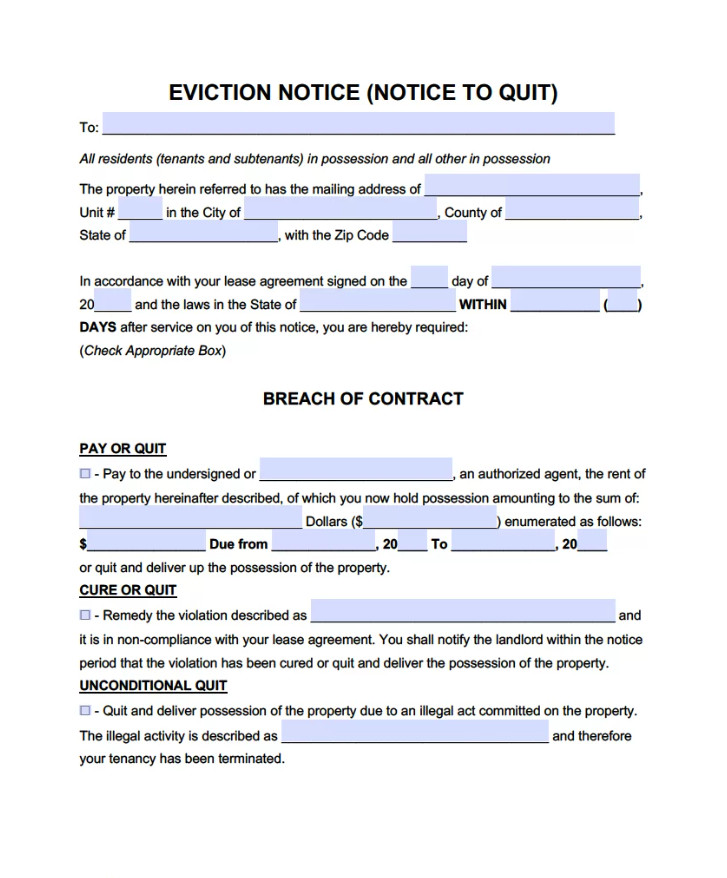Dealing with a tenant who has failed to pay rent or violated the terms of their lease can be a challenging situation for landlords. In such cases, an eviction notice is a crucial step towards resolving the issue. An eviction notice provides a written notification to the tenant, informing them of their violation and the consequences if they fail to rectify the situation.
This article will explore what an eviction notice is, why it is necessary, how to create one and provide tips for successful eviction proceedings.
What is an Eviction Notice?
An eviction notice is a written document that notifies a tenant of their violation of the terms of their lease or their failure to pay rent. It serves as a formal warning and the first step in the eviction process. The notice typically includes details such as the reason for eviction, the timeframe for the tenant to rectify the violation, and the consequences if they fail to comply.
Why is an Eviction Notice Necessary?
Providing an eviction notice is necessary for several reasons.
- It ensures that the tenant is aware of their violation or failure to pay rent, allowing them to rectify the situation before further legal action is taken.
- It serves as a formal record of the landlord’s attempt to resolve the issue peacefully. This record can be crucial if the case goes to court.
- An eviction notice helps protect the landlord’s rights and provides a clear timeline for the eviction process.




How to Create an Eviction Notice
Creating an eviction notice requires careful consideration and adherence to legal requirements. Here are the steps to follow:
- Review local laws: Familiarize yourself with the eviction laws specific to your jurisdiction. This will ensure that your eviction notice is legally valid.
- Gather necessary information: Collect all the relevant details about the tenant, the property, the violation, and the terms of the lease.
- Choose the right template: There are numerous eviction notice templates available online. Select one that aligns with your needs and local regulations.
- Personalize the notice: Fill in the template with the specific details of the violation, the timeframe for rectification, and any other relevant information.
- Serve the notice: Deliver the eviction notice to the tenant according to your jurisdiction’s requirements. This may involve sending it via certified mail or delivering it in person.
- Retain a copy: Keep a copy of the eviction notice for your records. This will be essential if legal action becomes necessary.
Example of an eviction Notice
Here is an example of what an eviction notice may look like:
[Your Name]
[Your Address]
[City, State, ZIP]
[Tenant’s Name]
[Tenant’s Address]
[City, State, ZIP]
[Date]
Dear [Tenant’s Name],
I am writing to inform you that you have violated the terms of your lease agreement for the property located at [Tenant’s Address]. Specifically, you have failed to pay rent for the months of [Unpaid Months]. As per the terms of your lease, rent is due on the [Due Date] of each month.
You are hereby given [Number of Days] days from the date of this notice to pay the outstanding rent in full. Failure to do so will result in further legal action, including eviction proceedings.
If you have any questions or concerns regarding this notice, please do not hesitate to contact me at [Your Phone Number] or [Your Email Address]. I strongly urge you to rectify this situation promptly to avoid any further action.
Sincerely,
[Your Name]
Tips for Successful Eviction Proceedings
Successfully navigating the eviction process requires careful preparation and adherence to legal requirements. Here are some tips to help ensure a smooth eviction:
- Document everything: Keep detailed records of all interactions, violations, and attempts to resolve the issue. This documentation will be invaluable if the case goes to court.
- Seek legal advice: Consult with an attorney who specializes in landlord-tenant law. They can provide guidance specific to your situation and help ensure you are following all legal procedures.
- Follow local laws: Familiarize yourself with the eviction laws in your jurisdiction and ensure you are following them precisely. Failure to do so can result in delays or even dismissal of your case.
- Communicate clearly: Communicate the terms of the eviction notice to the tenant, including the violation, the timeframe for rectification, and the consequences of non-compliance.
- Act promptly: Begin the eviction process as soon as legally permissible to minimize any further financial losses.
- Consider mediation: In some cases, mediation may be a viable option to resolve conflicts and reach an agreement without going to court.
- Follow through with legal action if necessary: If the tenant fails to comply with the eviction notice, consult with your attorney and proceed with the necessary legal action to reclaim your property.
Free Eviction Notice Template!
An eviction notice is a crucial tool in resolving issues with non-paying or non-compliant tenants. By providing a formal written notification, landlords can protect their rights while allowing tenants to rectify the situation.
Following the proper legal procedures and seeking professional guidance when necessary will help ensure a successful eviction process.
Eviction Notice Template Word – Download
